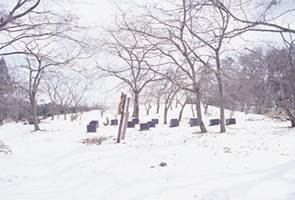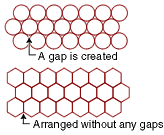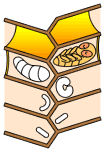In the bee farm, it is now the most silent season of the year.
It sometimes snows and bees huddle together in the beehives, waiting for the spring. Opening the cover of the beehive or inspecting the internal condition during this period when the weather is coldest is strictly prohibited because doing so would lower the temperature inside the hive.
Then, what do the beekeepers do in the winter? Instead of the outside work, we make, in the beekeeping hut, the "beehive base frames" to be used as a base for the new beehive of bees in the coming spring. This beehive base is a thin plate made of beeswax and a hexagonal pattern is embossed on both sides. If you place a beehive frame with this beehive base in a beehive box, bees will make the well-known hexagonal beehive on the beehive frame.
 |
 |
|
(Figure 1)
|
I would now like to talk about a mysterious aspect of the beehive. If I ask a question "What is the shape of a beehive honeycomb?" in "Bee Class" held by our company, all of the children answer "Hexagonal!" in a loud voice. But if I ask them "Why is it hexagonal?" they tilt their heads with a puzzled look on their faces. I once got an interesting reply: "Because bees have six limbs." In fact, it is assumed that bees are actually trying to create round honeycombs. We cannot know what bees are really thinking, but it is safe to say that they are trying to create the maximum amount of space with a minimal amount of material.
The hexagon is said to be the most efficient in this regard because the circle or octagon create gaps and the triangle or square makes the area smaller. (Figure 1) |
 |
|
(Figure 2) |
|
This form in which hexagons are placed side by side is called the honeycomb structure. This structure is known structurally as a very strong form and I heard that this form is also applied to the design of airplane wings and the walls of artificial satellites. Moreover, the rear of the honeycomb cells that make up the honeycomb walls are linked staggered by one half the height of each cell.
The point at which the rear sides of the hexagons intersect becomes the center of the hexagon at the rear side. (Photo 1) This strengthens the cells so that the bottom of the hole does not break easily. Also, by viewing the cross section, you can see that the cells on both sides are inclined upward. (Figure 2)
|
|
Worker bees rear children and store honey and pollen in these cells. They have the inclination of 9 to 14 degrees to ensure that honey does not leak out. We are really amazed at how ecological bees are and at the mechanism of the beehive. It's simply a wonderful invention of the natural world. The world of bees still holds numerous mysteries. A look at a beehive should be enough to suggest to us how nature's creativity is something that human knowledge cannot match.
Bees have existed as insects with superior social order for a period far longer than that covered by human history, providing people with many blessings such as honey, royal jelly, propolis, pollen, and beeswax. At the start of the new century, while making beehive base frames, I was suddenly struck at how creative and mysterious bees are. Though it is still cold, spring is sure to come. I hope to complete the preparations for the entire year by the time the plum flowers start to bloom. |
|






